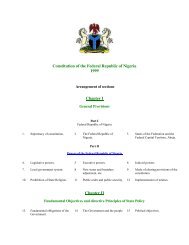Economic Recovery Growth Plan (ERGP) 2017-2020
This Medium Term Plan of the Federal Republic of Nigeria was designed to tackle the huge decline in the country’s economy since her shift from agriculture sector to crude oil and gas sector in the late 1960s. The plan’s objective includes restoring growth, investing in citizens and building a globally competitive economy.
This Medium Term Plan of the Federal Republic of Nigeria was designed to tackle the huge decline in the country’s economy since her shift from agriculture sector to crude oil and gas sector in the late 1960s. The plan’s objective includes restoring growth, investing in citizens and building a globally competitive economy.
You also want an ePaper? Increase the reach of your titles
YUMPU automatically turns print PDFs into web optimized ePapers that Google loves.
contracts and the enforcement of regulatory frameworks – to empower the private sector to effectively<br />
partner with Government to drive economic recovery and growth.<br />
2.4 FISCAL POLICY<br />
Fiscal policy is at the heart of the Federal Government’s macroeconomic management. The current<br />
recession is largely a result of fiscal challenges affecting public finances at the Federal, State and Local<br />
Government levels. A coherent, clear approach is required to increase revenues, optimize public<br />
expenditure and manage public debt.<br />
Consolidated Federal Government revenues declined from N3,362 billion in 2013 to N3,199 billion in<br />
2015 (Table 2.5). The sharp decline in oil prices and up to 60 per cent fall in crude oil exports due to<br />
sabotage and attacks on oil export terminals and pipelines have reduced overall revenues. Non-oil<br />
revenues increased from N1, 357 billion in 2013 to N1, 967 billion in 2015, but this remains low as a share<br />
of GDP when compared to other emerging economies: Nigeria’s peers raise an average 16 per cent of GDP<br />
from non-resource taxes; Nigeria raises just 3 per cent (2015).<br />
Historically, Federal Government expenditures have remained relatively high, although they are small as<br />
a share of GDP. Expenditures increased slightly from N4, 064 billion in 2012 to N4, 550 billion in 2015.<br />
State and Local Governments were seriously affected by these fiscal challenges and most were unable to<br />
meet their recurrent expenditure obligations, notably payment of salaries, pensions and overhead costs.<br />
Table 2.5: Federal Government Fiscal Operations (N billion), 2010-2015<br />
2010 2011 2012 2013 2014 2015<br />
Total revenues 2,670 3,304 3,019 3,362 2,631 3,199<br />
Oil revenues 1,216 2,191 1,637 2,005 1,486 1,232<br />
Non-oil revenues 1,454 1,113 1,382 1,357 1,145 1,967<br />
Total expenditures 4,064 4,299 4,131 4,516 4,123 4,550<br />
Recurrent expenditures –<br />
personnel<br />
Recurrent expenditures –<br />
other<br />
1,380 1,854 1,811 1,861 1,652 1,869<br />
1,157 673 590 526 561 681<br />
Debt service 416 527 679 828 942 1,060<br />
Other 210 326 307 388 381 556<br />
Capital expenditures 900 919 744 913 588 384<br />
Fiscal deficit (1,393) (995) (1,112) (1,153) (1,492) (1,351)<br />
FGN total debt 5,323 6,494 7,552 8,489 9,536 10,949<br />
Foreign debt (N) 772 871 1,014 1,370 1,632 2,112<br />
Foreign debt (USD billion) 4,534 5,666 6,527 8,821 9,711 10,718<br />
Domestic debt 4,552 5,623 6,538 7,119 7,904 8,837<br />
Source: MBNP, DMO, OAGF<br />
The Federal Government has improved its budgeting process through a series of medium-term sector<br />
strategies (MTSS) that link annual budgets for individual MDAs to common objectives. It periodically<br />
publishes budget implementation reports to monitor progress on project execution and improve<br />
40





